Mainz
![]()
The title of this article is ambiguous. For other meanings, see Mainz (disambiguation).
Mainz ( ![]() ) (lat. Mogontiacum) is the capital of the state of Rhineland-Palatinate and with 217,123 inhabitants also its largest city. Mainz is free of counties, one of the five Rhineland-Palatinate regional centers and part of the Rhine-Main area. Together with the adjacent Hessian state capital Wiesbaden, it forms a cross-state double centre with around 500,000 inhabitants on 301.67 km². Mainz and Wiesbaden are the only two state capitals of German territorial states with a common city boundary.
) (lat. Mogontiacum) is the capital of the state of Rhineland-Palatinate and with 217,123 inhabitants also its largest city. Mainz is free of counties, one of the five Rhineland-Palatinate regional centers and part of the Rhine-Main area. Together with the adjacent Hessian state capital Wiesbaden, it forms a cross-state double centre with around 500,000 inhabitants on 301.67 km². Mainz and Wiesbaden are the only two state capitals of German territorial states with a common city boundary.
Founded in Roman times, the city is home to Johannes Gutenberg University, the Roman Catholic bishopric of Mainz, and several television and radio stations, such as Südwestrundfunk (SWR) and Zweites Deutsches Fernsehen (ZDF). Mainz is a stronghold of the Rhenish carnival.

The old town of Mainz with parts of the cathedral in the background
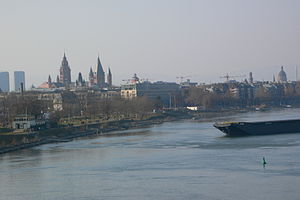
View of Mainz with the Bonifazius Towers and the Cathedral

Official logo of the state capital Mainz

Flag of the state capital Mainz
Geography
Mainz is located at an altitude of 82 to 245 m above sea level. The city lies on the western (left) bank of the Rhine, which forms the eastern city boundary, at Rhine kilometre 500 approximately halfway between Lake Constance and the North Sea. To the south and west, the city is bounded in the Mainz Basin by the edge of the Rhine-Hessian plateau, and to the north extends a riparian foreland receded from the Rhine. The 50th parallel of northern latitude runs through Mainz.
Location
The city of Mainz is located opposite the mouth of the Main River on the Rhine. In the immediate vicinity - apart from the directly neighbouring Wiesbaden - are the major cities of Frankfurt am Main, Darmstadt, Ludwigshafen am Rhein and Mannheim.
The six former districts of Mainz-Amöneburg, Mainz-Kastel and Mainz-Kostheim ("AKK") on the right bank of the Rhine, as well as Mainz-Bischofsheim, Mainz-Ginsheim and Mainz-Gustavsburg ("BGG") form a special political feature. After the Second World War, due to the demarcation between the American and French occupation zones, the AKK districts were handed over to the trustee administration of the city of Wiesbaden or became independent municipalities in the Hessian district of Groß-Gerau as Bischofsheim and Ginsheim-Gustavsburg. According to the attitude towards life of many inhabitants, the AKK districts still belong to Mainz today, which is expressed, among other things, in the infrastructure oriented towards Mainz. The city of Mainz describes them as "de facto belonging to Mainz". Due to the legally never fully completed transfer of territory to Wiesbaden, they still bear the prefix "Mainz-" in their official name (see also AKK conflict and Mainz districts on the right bank of the Rhine).
Neighboring communities
The following cities and municipalities border the city of Mainz. They are named clockwise starting in the north:
- on the right bank of the Rhine (Hesse): Wiesbaden, the
capital of the Land (independent city, including Mainz-Amöneburg, Mainz-Kastel and Mainz-Kostheim)
and Ginsheim-Gustavsburg (district of Groß-Gerau). - on the left bank of the Rhine
, the municipalities belonging to the district of Mainz-Bingen:
Bodenheim, Gau-Bischofsheim and Harxheim (all in the municipality of Bodenheim),
Zornheim, Nieder-Olm, Ober-Olm, Klein-Winternheim and Essenheim (all in the municipality of Nieder-Olm),
Ingelheim am Rhein with the districts of Wackernheim and Heidesheim am Rhein and
Budenheim (independent municipality).
City breakdown
The city of Mainz is divided into 15 local districts. Each local district has a local council consisting of 13 directly elected members and a directly elected head of the local council, who is the chairman of the local council.
The local advisory council is to be heard on all important issues that affect the local district. However, the final decision on a measure is then incumbent on the municipal council of the city of Mainz. In addition, there are seven planning areas, 65 city districts and 183 statistical districts, which also correspond to the voting districts.
The districts Altstadt, Hartenberg-Münchfeld, Neustadt and Oberstadt correspond (without Münchfeld, which previously belonged to Gonsenheim) to the former district Mainz-Innenstadt, which was dissolved in 1989.
Local districts
| Population with main and secondary residence in the local districts according to the population register as of 31 December 2020 | ||||||||||
| No. | Local district | Coat of arms | Surface area |
|
|
|
| Foreigner |
| NoteCommunity partsResidential places, |
| 15 | Old Town |
| 2,414 | 17.360 | 448 | 17.808 | 7.191 | 3.176 | 18,3 | |
| 16 | New Town |
| 3,661 | 28.931 | 401 | 29.332 | 7.902 | 6.634 | 22,9 | |
| 24 | Upper Town |
| 5,868 | 21.730 | 374 | 22.104 | 3.703 | 4.234 | 19,5 | |
| 25 | Hartenberg-Münchfeld |
| 3,427 | 18.208 | 421 | 18.629 | 5.313 | 3.883 | 21,3 | |
| 31 | Mombach |
| 6,316 | 13.778 | 97 | 13.875 | 2.181 | 3.713 | 26,9 | |
| 41 | Gonsenheim |
| 9,127 | 24.788 | 271 | 25.059 | 2.716 | 3.940 | 15,9 | DraisberghofKriegersmühleWendelinusheim |
| 42 | Finthen |
| 11,061 | 14.423 | 93 | 14.516 | 1.304 | 2.213 | 15,2 | Am GeiersköpfelLayenhof |
| 51 | Bretzenheim |
| 10,651 | 19.606 | 321 | 19.927 | 1.841 | 2.804 | 14,3 | Old brickyardHeilig |
| 52 | Marienborn |
| 3,015 | 4.458 | 52 | 4.510 | 1.479 | 944 | 21,2 |
|
| 53 | Lerchenberg |
| 2,411 | 6.457 | 147 | 6.604 | 2.678 | 1.260 | 19,5 | |
| 54 | Drais |
| 3,078 | 3.112 | 48 | 3.160 | 1.011 | 204 | 6,6 | |
| 61 | Hechtsheim |
| 14,043 | 15.544 | 143 | 15.687 | 1.107 | 2.190 | 14,1 | Tree nursery in the Speß |
| 62 | Ebersheim |
| 9,833 | 6.007 | 53 | 6.060 | 611 | 802 | 13,4 | |
| 71 | Weisenau |
| 4,056 | 13.422 | 138 | 13.560 | 3.309 | 3.155 | 23,5 | Am GroßbergLothary-Aue |
| 72 | Laubenheim |
| 8,789 | 9.078 | 115 | 9.193 | 1.033 | 1.062 | 11,7 | Gutshof Laubenheimer HöheKilianshof |
| state capital Mainz |
| 97,750 | 216.902 | 3.122 | 220.024 | 2.219 | 40.214 | 18,6 | ||
Note: Key figures refer to the inhabitants with their main residence in the respective part of the territory.
| Population with main residence in the AKK suburbs according to the population register as of 28 February 2021 | ||||||||
| No. | Local district | Coat of arms | Surface area |
|
| Foreigners |
| NoteCommunity partsResidential places, |
| 51 | Amöneburg |
| 3,71 | 1.765 | 476 | 641 | 36,3 | |
| 52 | Kastel |
| 9,51 | 13.353 | 1.404 | 3.751 | 28,1 | |
| 53 | Kostheim |
| 9,53 | 14.369 | 1.508 | 3.113 | 21,7 | |
| State capital Wiesbaden (AKK share) |
| 22,75 | 29.487 | 1.296 | 7.505 | 25,5 | ||
Incorporations
The table below this section lists formerly independent municipalities and parishes that were incorporated into the city of Mainz as part of the incorporation process. The separation of the districts on the right bank of the Rhine after the Second World War was compensated for by further incorporations in 1969. From 1962 onwards, a completely new district, Lerchenberg, was created.
| Year | Locations | Increase in hectares |
| 13th century | Selenhofen (together with Altmünsterkloster) | approx. 5 |
| 1294 | Vilzbach | ? |
| 23 May 1805 | Zahlbach | 120 |
| April 1, 1907 | Mombach | 608 |
| April 1, 1908 | Kastel with Amöneburga) | 1.332 |
| January 1, 1913 | Kostheima) | 953 |
| January 1, 1930 | Bretzenheim, Weisenau | 1.733 |
| January 1, 1930 | Bischofsheimb), Ginsheim-Gustavsburgb) | 2.407 |
| April 1, 1938 | Gonsenheim | 1.058 |
| April 16, 1964 | Lerchenberg | 241 |
| June 7, 1969 | Drais, Ebersheim, Finthen, Hechtsheim, Laubenheim, Marienborn | 4.778 |
(a) relocated to Wiesbaden in August 1945
(b) since July 1945, independent municipalities in the district of Groß-Gerau in the Land of Hessen
See also: List of local districts in the state capital Mainz
Climate
The annual precipitation is 613 mm and is thus in the lower quarter of the values recorded in Germany. The driest month is February, the most rain falls in June. In this month, precipitation is on average 1.7 times higher than in February. The precipitation hardly varies and is evenly distributed over the year.
The mean annual temperature in the period 1961 to 1990 was 10.1 °C, which is well above the German average.
Climate diagram for the city of Mainz
| Mainz | ||||||||||||||||||||||||||||||||||||||||||||||||
| Climate diagram | ||||||||||||||||||||||||||||||||||||||||||||||||
| ||||||||||||||||||||||||||||||||||||||||||||||||
| Monthly average temperatures and precipitation for Mainz
Source: Intellicast | ||||||||||||||||||||||||||||||||||||||||||||||||||||||||||||||||||||||||||||||||||||||||||||||||||||||||||||||||||||||||||||||||||||||||||||||||||||||||||||||||||
Climate emergency
In its meeting on September 25, 2019, the Mainz City Council declared a climate emergency. A joint supplementary motion by city council members of several parties approved the corresponding motion with a large majority and only with dissenting votes from the AfD. According to the motion, all future decisions, projects and processes of the administration should be subject to a climate protection proviso in order to achieve the goals of the Paris Climate Agreement of 2015.

Fluctuations in precipitation in Mainz

Augustinerstraße in the old town of Mainz, 2013
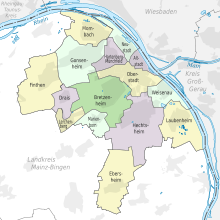
Mainz districts
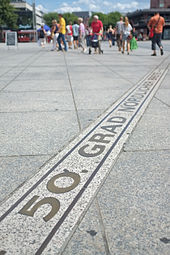
50th latitude on Gutenbergplatz
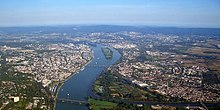
Aerial view of Mainz (left side of the Rhine) and Mainz-Kostheim with Mainz-Kastel (right side of the Rhine)
History
→ Main article: History of the city of Mainz
Prehistory and Roman times
→ Main article: Mogontiacum
The urban area of today's Mainz was already a resting place for hunters during the last Ice Age 20,000 to 25,000 years ago, as evidenced by relics discovered during excavations in 1921.
However, the first permanent settlements in the Mainz city area are of Celtic origin. The Celts were the dominant force on the Rhine in the second half of the first millennium BC. From these Celtic settlements and the Celtic deity Mogon (roughly comparable to the Greek-Roman Apollo) associated with them, the Romans arriving on the Rhine after the Gallic War (52 BC) derived the name "Mogontiacum" for their new legionary camp. For a long time it was assumed that this camp was founded around 38 BC. However, more recent research has shown that the camp (and thus ultimately the city of Mainz) was founded later, around 13/12 BC by Drusus.
After the double legion camp Mogontiacum had been founded, the camp, which is located in the area of today's Kästrich, was very quickly surrounded by individual settlements (lat. cannabae). The two legions needed craftsmen and tradesmen to maintain their operational capability. These settlements are the starting point of the urban development of Mainz. The city subsequently belonged to the Imperium Romanum for about 500 years and was the capital of the province Germania superior from about 89 AD and, from the 4th century, Germania prima. Unlike Cologne, the capital of the second Germanic province, Mogontiacum does not seem to have been elevated to colonia status. Above all, the great Rhine bridge made the place economically and strategically important. In the second half of the 3rd century the first city wall was built. From the middle of the 4th century at the latest, a Christian community existed in the city under the leadership of a bishop. No legion seems to have been stationed in Mainz since about 350.
The medieval bishop's town
Around 406 Mainz was conquered and plundered by Vandals, Alans and Suebi. After the period of the so-called migration of peoples, during which Western Rome disintegrated, the city gradually began to rise, finally coming under Frankish rule around 480 at the latest. Its function as a transhipment point for trade goods of all kinds (later mainly trade fair goods destined for Frankfurt) accelerated the city's development. It was mainly the area between the old Roman camp and the Rhine that remained populated.
At the end of this development stood an outstanding importance on a cultural, religious and political level. From the middle of the 8th century, the Christianization of the East, especially of the Saxons, was actively pursued from Mainz by Archbishop Boniface. In 782 Mainz was elevated to the status of archbishopric. The ecclesiastical province subsequently developed into the largest on this side of the Alps. In the 9th and 10th centuries Mainz acquired the title of Aurea Moguntia. The influence of the archbishops of Mainz caused them to rise to become Chancellors of the Empire, sovereigns of the territory of the Electorate of Mainz, and electors of kings (electors). Archbishop Willigis (975-1011) had Mainz Cathedral built as a sign of his power and, as imperial administrator, was for a time the determining man in the empire. In the course of this rise of spiritual power in secular affairs, the city of Mainz itself had fallen under the control of its archbishop.
The High Middle Ages brought special privileges for the citizens for the first time, which were granted to them by Archbishop Adalbert I of Saarbrücken (1110-1137). They included above all tax exemptions and the right to stand trial only within the city. However, after the assassination of Archbishop Arnold von Selenhofen in 1160, these privileges were revoked. In addition, the city walls were razed by order of Emperor Frederick Barbarossa. Although thus scarred, Mainz was soon once again the centre of imperial politics. As early as 1184, Frederick Barbarossa invited the elite of the empire to Mainz for a court day on the occasion of the Schwertleite of his sons, which is considered by some chroniclers to be the greatest festival of the Middle Ages. As early as 1188, he came to Mainz again for the "Court Day of Jesus Christ" on the occasion of the Third Crusade. Along with Speyer and Worms, Mainz was considered one of the SchUM cities and the birthplace of Ashkenazi culture.
In 1212 Siegfried II of Eppstein crowned Frederick II, Emperor of the Hohenstaufen dynasty, as king in Mainz Cathedral. Frederick II returned to Mainz in 1235 to hold an imperial diet there. At this, the "Mainzer Landfriede" was enacted on 15 August.
Free City of Mainz
In the disputes between the Staufers and their opponents, which became increasingly fierce in the 1240s, the citizens of Mainz allowed themselves to be wooed by both sides. The consequence of this policy was that the citizens received a comprehensive city privilege from Archbishop Siegfried III of Eppstein in 1244 as the price for their support. The archbishop was then only formally the head of the town; self-administration, jurisdiction and the power to decide on new taxes passed to the citizens or the 24-member town council. In addition, the privilege released the citizens from their obligation to obey in all warlike disputes that did not concern the city's defence. From this point on, Mainz was a "free city".
The period as a free city (until 1462) is considered the high point of the city's history. The political influence of the citizens reached its highest municipal and supra-regional significance during this time, to which the founding of the Rhenish League of Towns in 1254 bears clear witness. Trade and commerce were able to flourish during this period, not least under the protection of the League of Towns and the guarantee of the Mainz Land Peace of 1235. Mainz rose to become an important economic centre.
From 1328, conflicts with the archbishop began the decline of the free burghers and their privileges. In the Mainz Collegiate Feud, the citizens sided with Archbishop Diether of Isenburg, who had made both the emperor and the pope his enemies. The city was taken in 1462 by Adolf II, Diether's rival for the office of archbishop. Adolf II then had the citizens of Mainz hand over all privileges to him and ended the period of the Free City. Mainz became the elector's residential city and subsequently developed into a metropolis of the nobility without any political significance of its own.
electoral capital
As his successor, Adolf II recommended Diether of Isenburg to the increasingly powerful Mainz cathedral chapter. In 1477, he founded the university already planned by Adolf II.
The Reformation, which began in 1517, initially had good prospects in Mainz. The printing press with movable type invented there around 1450 by Johannes Gutenberg enabled the Reformation writings to spread rapidly, and the Archbishop of Mainz and Cardinal Albrecht of Brandenburg was initially open to their ideas. In the end, however, it could not prevail in Mainz. Twice the cathedral chapter elected Catholic archbishops by a narrow majority. With the exception of garrison congregations, no Protestant congregation was allowed to form in the city until 1802.
From the middle of the 16th century, the medieval city fortifications had given way to a more modern fortification that eventually encompassed the entire city. No stone buildings were allowed to be built outside this fortification in order not to be able to offer protection to approaching troops. Therefore, the city could only develop in the open spaces that remained within the walls, which severely limited the city's growth until the 20th century.
Despite this fortress, Mainz was taken without a fight by the Swedish army during the Thirty Years' War. A major contribution to the end of the war was made by Johann Philipp von Schönborn, who became Archbishop of Mainz in 1647 and under whose pontificate the city was able to recover quickly from the devastation of the war. After this war, jurisdiction in the Electorate of Mainz was reorganised and, from 1682, compulsory schooling was introduced, which had otherwise already existed since 1649.
In the now emerging baroque period, splendid buildings were erected in the city, which are still part of the townscape today. With the term of office of the Elector Emmerich Joseph von Breidbach zu Bürresheim (1763-1774), the Enlightenment also entered the "City of Nobility" on a political level.
The end of the old order
The ideas of the Enlightenment eventually led to the Revolution in France. In 1790, the so-called Mainz Knot Rebellion had occurred. After France had conquered the left bank of the Rhine, including Mainz, in the coalition wars of 1792, Prince-Bishop Friedrich Karl Joseph von Erthal had to flee the city. In March 1793, the occupying power arranged for the establishment of the "Mainz Republic" and had the first free elections held, but this ended in July of the same year after the Prussian siege and shelling of the city and the withdrawal of the French. A French siege in 1795 was unsuccessful, but the withdrawal of the Austrian garrison after the Peace of Campo Formio led to the next French occupation of the city in late 1797. The nobility disappeared from Mainz, leaving the city to become bourgeois. Like all the territories on the left bank of the Rhine, Mainz was annexed by France and, as Mayence, became the capital of the French Département du Mont-Tonnerre (named after the Donnersberg) under the administration of the French prefect Jeanbon St. André.
Mainz in the Grand Duchy of Hesse
Due to the loss of its residential function, the city, which belonged to the Grand Duchy of Hesse since 1816, became very provincialized in the 19th century. Significant supra-regional events are therefore hardly to be found in the city's history at this time. However, Mainz was the seat of the Mainz Central Investigation Commission during the persecution of demagogues as a result of the Carlsbad resolutions. The Mainz Fastnacht, which developed from 1837 onwards, is of lasting significance.
The fortress function (now a federal fortress of the German Confederation) also hindered the expansion of the city and the development of the number of inhabitants. Until the end of the fortress, the city almost never had more than 30,000 inhabitants. Near Mainz, seventeen Rhine mills lay chained together and anchored to the pier remains of a Roman bridge around 1856. When the last free spaces within the fortress, such as the Kästrich, were built on from the 1850s onwards and the banks of the Rhine were shifted to the north-east in the 1880s, the number of inhabitants within the old town was able to increase significantly. However, due to its function as a fortress, the city was not able to grow as much as Wiesbaden, for example.
The most significant development of the city, however, occurred through the incorporation of the "Gartenfeld" or New Town. This newly built city wall extension triggered a building boom and population growth in the Gründerzeit from 1872 onwards, which was, however, slowed down for the time being by the stock market crash in 1873. This expansion was made possible not least by the loss of importance of the fortress (from then on the fortress of Metz served as a bulwark of the German Empire against France) after the Franco-Prussian War of 1870/71. From 1886 onwards, building activity in the Neustadt (and with the relocation of the main railway station away from the banks of the Rhine also in the Lauterenviertel during this period) increasingly continued.
It was not until shortly before the First World War that the old fortified structures were finally demolished, so that the city could now expand outside its previous walls. The expansion of the city triggered by this and by the extensive incorporations led to further population growth.
In 1852 a 1.7 kilogram stone meteorite of the type L6 was found on a field near Mainz. The place of discovery is built on today and is located near the Pariser Straße.
After Mainz had already hosted the 4th German Fire Brigade Day in 1860, the 16th German Fire Brigade Day was held in Mainz from 3 to 6 September 1904. It was the first after the turn of the century.
Modern Mainz
The First World War ended the brief upswing that had begun after the city walls were breached. After the war, the Golden Twenties almost completely passed Mainz, which was once again occupied by the French until June 1930. After the end of the occupation, there were again extensive incorporations (see table above), which doubled the city area. On November 1, 1938, Mainz, like Offenbach am Main, Gießen, Darmstadt and Worms, became a district-free city.
National Socialism was initially unable to gain a foothold in Mainz. Even at the time of the seizure of power on 30 January 1933, more people demonstrated against the new system than for it. Nevertheless, the 3000-member Jewish community of Mainz was almost completely deported. The city was spared from the Second World War until 1942. The first heavier bombing raids escalated to the worst attack on February 27, 1945, when Mainz was almost completely destroyed by British bombers, killing about 1200 people. Incendiary bombs had ignited a firestorm. By the end of the war, 80% of the city had been destroyed. On March 21, 1945, Mainz was finally occupied by US troops as part of Operation Undertone. The war, which was still continuing elsewhere in Germany, ended on 8 May with the unconditional surrender of the Wehrmacht.
After the war, Mainz was again occupied by the French. The border between the French and American occupation zones was formed by the Rhine at the height of Mainz, which is why the districts on the right bank of the Rhine were separated. Following a suggestion from the Wiesbaden regional council, the districts north of the mouth of the Main, Amöneburg, Kastel and Kostheim, were incorporated into Wiesbaden, which is one reason for the rivalry between the two cities today. The districts south of the Main on the right bank of the Rhine, Bischofsheim, Ginsheim and Gustavsburg, became independent municipalities again in the district of Groß-Gerau. The new formation of the states of Hesse and Rhineland-Palatinate cemented this division. As early as 1946, the university, which had been abolished in 1798, was re-established. In 1946, Mainz was designated the capital of the newly formed state of Rhineland-Palatinate by Decree No. 57 of the French occupation administration and assumed this function in 1950 in place of the previous provisional seat of government, Koblenz. Mainz was thus able to end the almost 150-year process of provincialization. After the Second World War, the population had fallen to about 76,000. It was not until the mid-1960s that it returned to its pre-war level.
In 1962, the city celebrated its 2000th anniversary, which was based on the (unsubstantiated) belief at the time that the Romans under Agrippa had founded a military camp at the confluence of the Rhine and Main rivers as early as 38 BC. The creation of Mainz-Lerchenberg as a new district after 1962, as well as large-scale incorporations around Mainz in 1969, ended the stagnation in urban development caused by the Second World War and offered extensive opportunities for expansion and development. With the settlement of the ZDF on the Lerchenberg, the development into a media city began in 1976, followed later by the settlement of a studio of the SWR and, for a time, the broadcasting centre of Sat.1. This development was reinforced by the Gutenberg Year 2000, which was celebrated with numerous activities. In addition to other urban development programmes such as the redevelopment of the old town, Mainz has also been involved in the federal-state programme "Socially Integrative City" since the aforementioned year. From 1969 until the end of 1995, Mainz was also the seat of the district administration of Mainz-Bingen, before this was relocated to Ingelheim.
On March 25, 2010, the Stifterverband für die Deutsche Wissenschaft (Donors' Association for the Promotion of Sciences and Humanities in Germany) awarded the city of Mainz the title of "City of Science" for 2011, and the city therefore organized numerous events, exhibitions and lectures in cooperation with Mainz's universities, associations and educational institutions.
On 23 December 2010, an earthquake with a value of 3.5 on the Richter scale occurred at around 02:36. The epicentre was in the Lerchenberg district. The earthquake did not cause any major damage. An aftershock (2.8 on the Richter scale) followed at 06:52. In neighbouring Wiesbaden, a value of 3.2 on the Richter scale was reached.
In September 2010, the New Synagogue was ceremoniously opened in Mainz's Neustadt district in the presence of the German President. In mid-2011, after two years of construction, the Coface Arena opened in the fields near Bretzenheim as the new venue for 1. FSV Mainz 05 (now Opel Arena). In December 2016, after 2.5 years of construction and at a cost of €90 million, the "Mainzelbahn" was put into operation as part of the largest tram project in Germany. Since then, lines 51 and 53 connect the main station via Bretzenheim and Marienborn with Lerchenberg. On 15 April 2018, a referendum was held in Mainz for the first time. Slightly more than 40% of the approximately 161,000 residents entitled to vote took part and voted with 77% against a building project decided by the majority of the city council, the "Bibelturm", as a new part of the Gutenberg Museum to be built.

enlarge and show information about the picture
![]()
Panorama of the modern state capital and university city of Mainz (photo 2008)
Population development
→ Main article: Population development of Mainz
In the first half of the 19th century, Mainz had a population of between 20,000 and 30,000; due to industrialization and the expansion of the city area into what is now Neustadt, this number grew in the following decades and had more than doubled between 1850 and 1900. In 1908, the city reached the 100,000 population mark for the first time, making it a major city. Since 1952, Mainz has had a permanent population of more than 100,000, and this number also increased in the following decades due to several incorporations. In 2011, it also passed the 200,000 inhabitants mark. At the end of 2017, 215,058 inhabitants had their main residence in Mainz. In the summer of 2019, the number of inhabitants (main and secondary residence) exceeded the threshold of 220,000 inhabitants, according to the city.

City view of Mainz around 1900

Federal fortress Mainz around 1844. lithograph by J. Lehnhardt

Mainz - Excerpt from the Topographia Hassiae by Matthäus Merian the Younger 1655
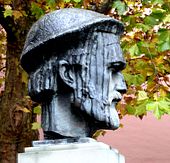
Johannes Gutenberg Monument in front of the Gutenberg Museum
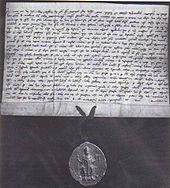
The Freedom Privilege of Siegfried of Eppstein
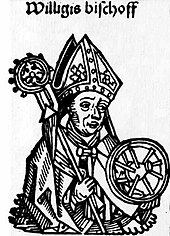
Depiction of Archbishop Willigis, the builder of Mainz Cathedral
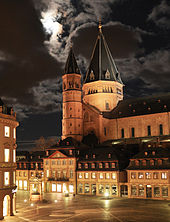
St. Martin's Cathedral in Mainz, in front of it the cathedral houses, Anno 1771 and the Renaissance draw well, donated by Archbishop Albrecht in 1526.
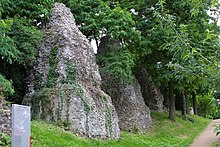
Relics from Roman times: the so-called Roman stones as relics of the old water supply system
Search within the encyclopedia